First impressions: New cab revitalises Case IH Optum tractor
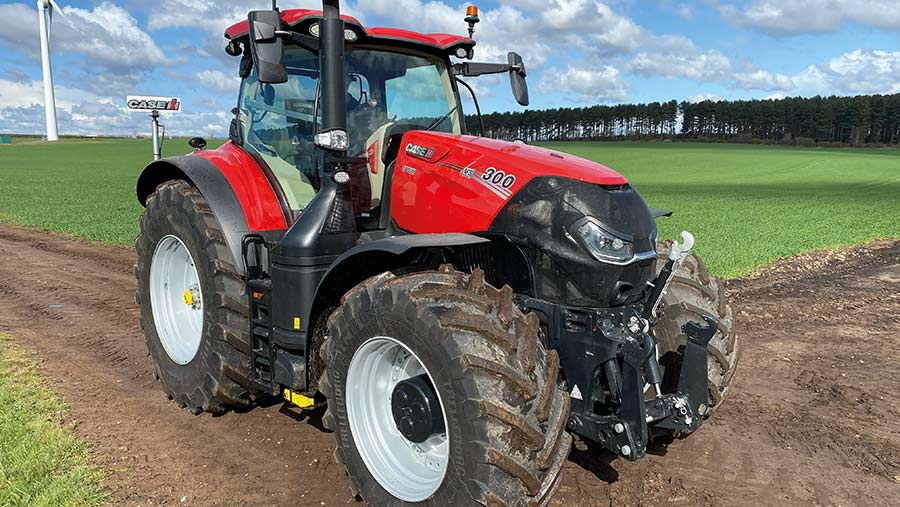 © MAG/Oliver Mark
© MAG/Oliver Mark The 250-300hp tractor division is red hot right now and the launch of Case IH’s Optum CVX and the equivalent New Holland T7 HD has cranked up the competition another notch.
Demand for compact high-horsepower tractors has surged since the original Optum debuted at the tail of 2015.
At that time, the shorter-framed, shorter-nosed alternative to the firm’s North American-built Magnum platform was designed to compete with the sector-leading Fendt 828 and John Deere 7R series – both of which were in high demand in Europe.
They remain the “big two”, but plenty of others have joined the fray, including both Massey Ferguson and Deutz-Fahr with recently renovated models.
Deere would argue that its popular 6R 250 should be in the conversation too, though it falls a tonne-and-a-half short of the Optum’s maximum permissible weight.
Given the welter of options, it’s no surprise that sales across all brands in the 250-300hp sector have more than doubled since 2015, with the high-water mark now set at 300 units/year.
In some cases, these have come from Puma owners wanting a bit more grunt, while others have traded weight for versatility by downgrading their Quadtrac.
Case has kept the Optum range as before, with the same three-model structure (250, 270 and 300) and just the one transmission option – the stepless CVXDrive.
Demand for powershifters in this bracket is exceptionally low and it’s the same story with long-wheelbase Pumas, where CVXs outsell the powershift equivalent at a rate of four to one.
See also: Ultimate guide to buying a tractor 2022
What’s new?
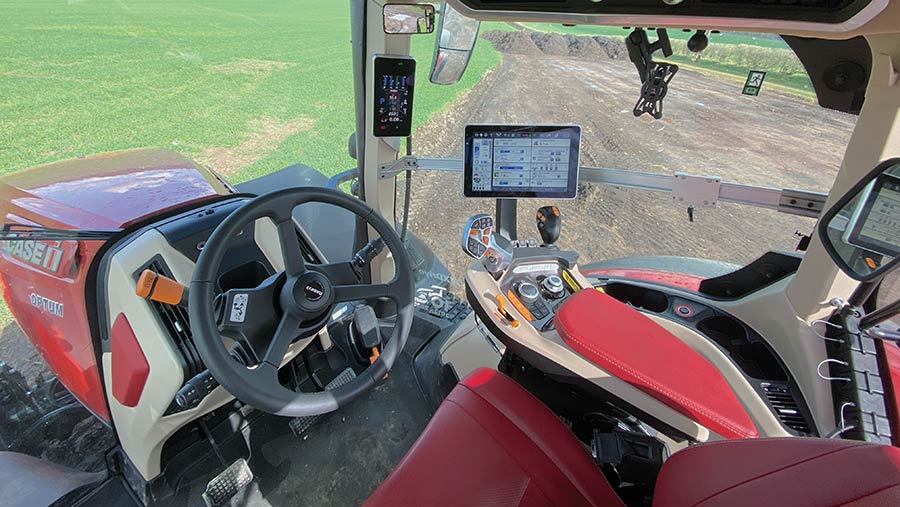
© MAG/Oliver Mark
CNH’s designers have focused all their efforts on the Optum’s Achilles heel – the cab.
An upgrade was long overdue, with the increasingly maligned structure of old having been in service since the 2008 launch of the Puma.
It has subsequently been used on all the firm’s European models, and New Holland equivalents, from the Vestrum upwards, so CNH has certainly had its money’s worth.
Lower fenders and a longer frame contrive to provide 7.5% more interior volume and allow for 11% more glass.
The result is lighter and brighter, though not quite a match for the conservatory-like cab of a Fendt.
The alterations mean there is one less step on the climb in, the door opening is wider and, as a result, access is marginally easier.
Drivers, especially those of the long-legged variety, can slide the seat further back without having their head touching the rear window and toecaps touching the front, and the dropped wheel arches have freed up more storage space.
At 65dBa, Case also claims a sector-leading level of cab hush, and there’s a more-effective climate control system that can, for the first time, fire an arctic gale from vents fitted behind the seat.
Entry is now via an automotive-style fob that doubles up as an immobiliser.
One of these can be assigned to multiple tractors to save carrying around a pocketful of keys, or multiple fobs can grant access to one tractor. This can be altered through Case’s online portal.
Spec options on UK-bound Optums are limited to the GPS package, top speed and tyres, plus whether it has a leather or fabric seat and 16 or 22 LED lights.
Case hopes this simplicity will speed up production and gradually help rein in lead times, which currently stand at about eight months – double the pre-Covid norm. Waits for US-built Magnums and Quadtracs are even longer.
What about the controls?
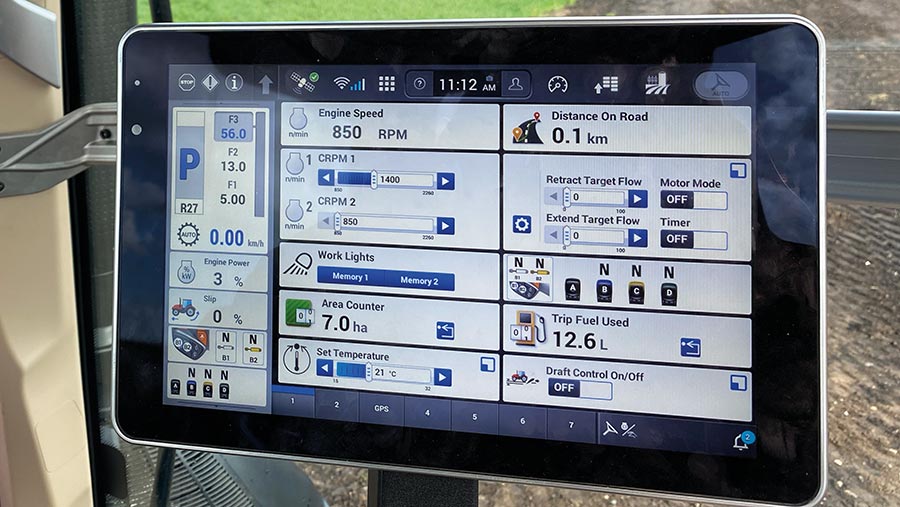
© MAG/Oliver Mark
New cab furniture includes the 12in AFS Pro 1200 touchscreen, which is already at home in the 2019-launched Magnum and big Quadtrac.
Its visuals are crisper than the teletext-grade resolution of the old Pro 700 (7in) and it can now be used to control both phone and multimedia, which will appeal to those accustomed to the creature comforts of green-liveried rivals.
But it works on the same principle as before, with a series of easily navigated “run” screens (previously six, now seven) displaying any combination of data, including guidance, performance stats and Isobus implement control.
The aim is to appeal to operators with varying levels of enthusiasm for screen time.
As a result, there are physical buttons and dials for every function available in the main touchscreen and, in the case of adjusting spool valves, four ways of doing the same job.
There’s also a post box-shaped, view-only display on the A-pillar for engine and transmission readouts.
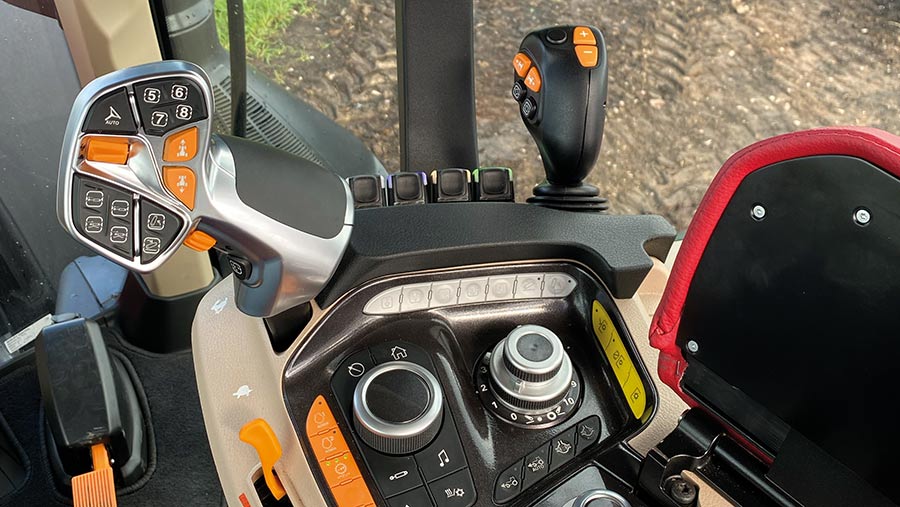
© MAG/Oliver Mark
Minor alterations to the Multicontroller joystick include a dedicated guidance engagement button for the first time.
There are also permanent controls for commonly used functions such as linkage raise/lower, along with four assignable buttons that can be used for everything from heating adjustment to headland management.
Remote access has been improved as well, allowing someone many miles away to guide the operator through the process of setting an AB line.
Similarly, dealers can delve into the diagnostics without visiting the field, updates can be installed automatically and job instructions or application maps can be sent directly to the tractor.
Any change to the engine?
Power and torque from the 6.7-litre engine remain as before, but there has been a rejig to beat Stage 5 emissions limits.
This has been achieved without exhaust gas recirculation, with engine provider FPT instead choosing to run the engine hotter to produce less soot but more NOx.
This is cleaned up by an SCR system with AdBlue and a particulate filter.
As a result, AdBlue consumption has risen from 3-5% on Stage 4 models to nearer 7% on the latest versions.
But the upside, says Case, is that burning cool, clean air rather than recirculating hot, dirty stuff means the engine uses fuel more efficiently.
The diesel tank is big too, with its 630-litre capacity bettering a John Deere 7R AutoPowr by more than 100 litres.
Interestingly, all FPT engines from 115hp to the 400hp block in the Magnum can run on HVO biofuel.
It’s currently niche but, with buying groups such as Fram Farmers now involved and some growers taking a keener interest in carbon counting, it may gain traction.
Stepless only
CNH Industrial builds its own transmissions in Belgium, and the only one available on the Optum is, in Case parlance, the CVXDrive.
The stepless gearbox has four imperceptible ranges, each offering a point of exclusively mechanical power transfer that is more efficient than oil.
The exact points that this happens vary slightly according to engine load, but one is below 10kph, there are a couple between 10 and 20kph, and another close to full transport speed.
In terms of controls, the Optum remains unorthodox in using a progressive drivestick that slides through a long gate to the top speed in each of three virtual speed ranges.
Most of the competition favour the Fendt-style self-centring format, where nudges fore and aft speed it up and slow it down.
Case’s engineers have tinkered with the transmission software on the new models, allowing for more customisation of acceleration/deceleration and shuttle aggressiveness – from Eeyore at one extreme to Red Rum at the other.
Few operators are likely to fiddle with these settings, but it means the Optum has the same configuration options as the 828 and 7R.
Setup of the Accuturn Pro headland turn system has been simplified too, with more customers apparently requesting extra automation as tractor cabs are transformed into mobile offices.
Dressed for field work
In its lightest form the Optum weighs about 10.5t, but the standard UK configuration is nearer 11.5t – or 13.5t when loaded up with ballast for heavy tillage.
One of the biggest decisions buyers will have to make is footwear, with the upgrade to very high flexion (VF) tyres – an increasingly popular option – costing roughly £3k per corner.
There has also been a noticeable shift towards Trelleborg, which some farmers reckon to be slower wearing than equivalent Michelins.
Case’s sales figures back up the anecdotal evidence, with the ratio of Michelin to Trelleborg dropping from 90:10 to 60:40.
In reality though, most buyers will have to take what they can get, as tyre companies are continuing to struggle with demand.
The Optum still runs a 223 litres/min closed centre pump, but with the pick-up hitch and hydraulic top link now plumbed into a proper diverter valve.
This saves permanently hogging spool valves, particularly given both are now pretty standard fitment on bigger tractors.
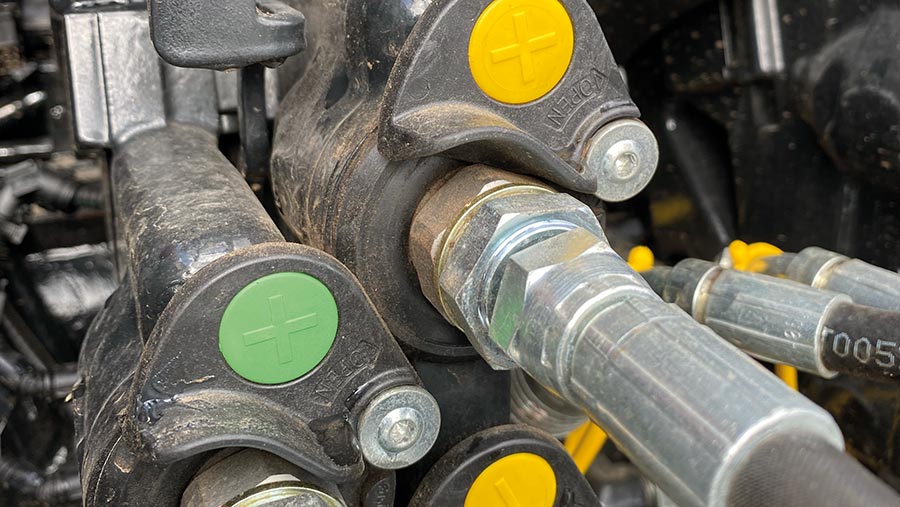
Spool pressure relief © MAG/Oliver Mark
But, more excitingly, Case has finally fitted pressure-relief levers on the spool block, meaning operators can simply press a tab to eject the pipe – a far more civilised arrangement than being forced to wrestle with them to the point of perspiration.
There’s also the option of hydraulic stabilisers that allow from-the-cab adjustment of the automatic lock-off height, plus capacity to plug in up to four external cameras.
A two-speed front pto is standard, which might allow contractors to save a bit of fuel with a set of triple mowers on third-cut silage.
Other improvements include air brake ports that are now angled downwards to make plugging in easier, a dedicated storage space for the pick-up hook under the exhaust, and the addition of both Isobus and engine speed controls on the rear fender.
Farmers Weekly verdict
Case might sell five times more long-wheelbase Pumas than Optums, but the company expects that gap to narrow.
The flagship 300 will inevitably be the most popular and, depending on the aggressiveness of dealers, might be £20,000-£40,000 cheaper on-farm than a Fendt or John Deere of equivalent power.
It’s going to be hard to make up that difference in the field and there’s now little to split them in terms of cab comfort.
There’s also the option of having it in blue – the New Holland T7 HD range is the same in all but cab furniture and driving software.
Case Optum 300 CVXDrive
-
- Engine Six-cylinder, 6.7-litre FPT
- Max power 313hp@1,800rpm
- Max torque 1,282Nm@1,400rpm
- Transmission Stepless CVXDrive
- Pto Four speeds
- Hydraulics 165 or 220 litres/min
- Spools Up to five rear and three mid-mount
- Max lift capacity 11,058kg
- Total permissible weight 16,800kg
- Price £250,000

